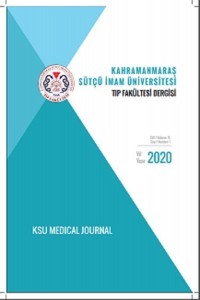Obezitede İnflamasyon ve İnsülin Direncine Etkili Hematolojik ve İnflamatuar Parametreler
Obezite, İnsülin resistansı, İnflamasyon, Kan grubu.
Hematological and Inflammatory Parameters Effective on Inflammation and Insulin Resistance in Obesity
Obesity, Insulin resistance, Inflammation, Blood groups.,
___
- World Health Organization. Obesity and overweight. [(accessed May 5, 2013)]. Available online: http://www.who.int/mediacentre/factsheets/fs311/en/
- Carr DB, Utzschneider KM, Hull RL, Kodama K, Retzlaff BM, Brunzell JD et al. Intra-abdominal fat is a major determinant of the National Cholesterol Education Program Adult Treatment Panel III criteria for the metabolic syndrome. Diabetes. 2004;53(8):2087-2094.
- Sok Lee Y, Olefsky J. Chronic tissue inflammation and metabolic disease. 2021;35(5-6):307–328.
- Qatanani M, Lazar MA. Mechanisms of obesity-associated insulin resistance: Many choices on the menu. Genes and Development. 2007;21(12):1443–1455.
- Gregor MF, Hotamisligil GS. Inflammatory mechanisms in obesity. Annu Rev Immunol. 2011;29:415–445.
- Rosen ED, Spiegelman BM. What we talk about when we talk about fat. Cell. 2014;156:20–44.
- Kojta I, Chacińska M, Błachnio-Zabielska A. Obesity, bioactive lipids, and adipose tissue ınflammation in ınsulin resistance. Nutrients. 2020;12(5):1305.
- Ewald DR, Sumner SC. Blood type biochemistry and human disease. Wiley Interdiscip Rev Syst Biol Med. 2016;8:517–535.
- Liumbruno GM, Franchini M. Beyond immunohaematology: The role of the ABO blood group in human diseases. Blood Transfus.2013;11:491–499.
- Feng JF, Chen S, Yang X. Systemic immuneinflammation index (SII) is a useful prognostic indicator for patients with squamous cell carcinoma of the esophagus. Medicine (Baltimore).2017;96(4):e5886.
- Topsakal S, Yerlikaya E, Akin F, Kaptanoglu B, Erürker T. Relation with HOMA-IR and thyroid hormones in obese Turkish women with metabolic syndrome. Eat Weight Disord 2012;17(1):e57-61.
- Goran MI, Lane C, Toledo-Corral C, Weigensberg MJ. Persistence of pre-diabetes in overweight and obese hispanic children; Association with progressive insulin resistance, Poor β-cell function, and increasing visceral fat. Diabetes.2008;57(11):3007–3012.
- Petersen MC, Shulman GI. Mechanisms of insulin action and ınsulin resistance. Physiol Rev.2018;98(4):2133–2223.
- Andersen CJ, Murphy KE, Fernandez ML. Impact of obesity and metabolic syndrome on immunity. Adv Nutr.2016;7(1):66-75.
- Cruz-Pineda WD, Parra-Rojas I, Rodríguez-Ruíz HA, Illades-Aguiar B, Matia-García I, Garibay-Cerdenares OL. The regulatory role of insulin in energy metabolism and leukocyte functions. J Leukoc Biol.2022;111(1):197-208.
- Hernandez Vera R, Vilahur G, Badimon L. Obesity with insulin resistance increase thrombosis in wild-type and bone marrow-transplanted Zucker Fatty rats. Thromb Haemost. 2013;109(2):319-327.
- Yang M, Qiu S, He Y, Li L, Wu T, Ding N et al. Genetic ablation of C-reactive protein gene confers resistance to obesity and insulin resistance in rats. Diabetologia. 2021;64(5):1169-1183.
- Aydin M, Yilmaz A, Donma MM, Tulubas F, Demirkol M, Erdogan M et al. Neutrophil/lymphocyte ratio in obese adolescents. North Clin Istanb. 2015;2(2):87-91.
- Liu H, Zhan F, Wang Y. Evaluation of monocyte-to-high-density lipoprotein cholesterol ratio and monocyte-to-lymphocyte ratio in ischemic stroke. J Int Med Res.2020;48(7):0300060520933806.
- Jin M, Yuan S, Yuan Y, Yi L. prognostic and clinicopathological significance of the systemic immune-inflammation ındex in patients with renal cell carcinoma: A meta-analysis. Front Oncol.2021;11:735803.
- Liu N, Mao J, Tao P, Chi H, Jia W, Dong C. The relationship between NLR/PLR/LMR levels and survival prognosis in patients with non-small cell lung carcinoma treated with immune checkpoint inhibitors. Medicine (Baltimore)202221;101(3):e28617.
- Karakaya S, Altay M, Kaplan Efe F, Karadağ I, Ünsal O, Bulur O et al. The neutrophil-lymphocyte ratio and its relationship with insulin resistance in obesity. Turk J Med Sci.2019;49(1):245–248.
- Erdal E, İnanir M. Platelet-to-lymphocyte ratio (PLR) and Plateletcrit (PCT) in young patients with morbid obesity. Rev Assoc Med Bras (1992).2019;65(9):1182-1187.
- Furuncuoğlu Y, Tulgar S, Dogan AN, Cakar S, Tulgar YK, Cakiroglu B. How obesity affects the neutrophil/lymphocyte and platelet/lymphocyte ratio, systemic immune-inflammatory index and platelet indices: a retrospective study. Eur Rev Med Pharmacol Sci.2016;20(7):1300-1306.
- Yu JY, Choi WJ, Lee HS, Lee JW. Relationship between inflammatory markers and visceral obesity in obese and overweight Korean adults: An observational study. Medicine (Baltimore)2019;98(9):e14740.
- Battaglia S, Scialpi N, Berardi E, Antonica G. Gender, BMI and fasting hyperglycaemia influence Monocyte to-HDL ratio (MHR) index in metabolic subjects. PLoS One.2020; 15(4):e0231927.
- Parveen N, Rehman J, Hassan SH, Hassan Z, Rehman M. Different blood groups association with body mass index in medical students of Karachi. Professional Medical Journal.2016;23(8):1001–1004.
- Fagherazzi G, Gusto G, Clavel-Chapelon F, Balkau B, Bonnet F. ABO and Rhesus blood groups and risk of type 2 diabetes: evidence from the large E3N cohort study. Diabetologia.2015;58(3):519-22.
- Sukalingam K, Ganesan K. Rhesus blood groups associated with risk to obesity and diabetes mellitus: A report on Punjabi population in Selangor, Malaysia. International Journal of Integrative Medical Sciences.2015;2(4):105–109.
- ISSN: 1303-6610
- Yayın Aralığı: Yılda 3 Sayı
- Başlangıç: 2004
- Yayıncı: Kahramanmaraş Sütçü İmam Üniversitesi
Tayibe BAL, Hasibullah YAQOOBİ, Yusuf ÖNLEN, Mehmet ÇABALAK, Serdar DOĞAN
Akromegali Hastalarında Hematolojik İndekslerin Değerlendirilmesi
Emek TOPUZ, Dilek TÜZÜN, Ümit Nur ÖZBAY, Murat ŞAHİN
Caner ÖLMEZ, Mehmet Kutlu DEMİRKOL, Muhammed SEYİTHANOĞLU, Sezen KOÇARSLAN, Faruk KÜÇÜKDURMAZ, Sefa RESİM
Kovid-19 Tanılı Bir Pediatrik Hastada Dikkat Eksikliği-Hiperaktivite Bozukluğu Tedavisi
Asiye ARICI GÜRBÜZ, Hatice ALTUN
Hashimoto Tiroidit’i ile Papiller Tiroid Karsinom Birlikteliği ve Prognoza Etkileri
Obezitede İnflamasyon ve İnsülin Direncine Etkili Hematolojik ve İnflamatuar Parametreler
Evre 4 ve 5 Kronik Böbrek Hastaları Metformin Kullanmamalı mı?
İlkokul Öğretmenlerinin Obeziteye Karşı Önyargı Durumları ve İlişkili Faktörler
Tıbbi Onkoloji Çalışanlarında Tükenmişlik: Ulusal Gerçeklerle Yüzleşmek
Özge KAMA BAŞCI, Ferhat EKİNCİ, Atike Pinar ERDOĞAN, Erhan ESER
